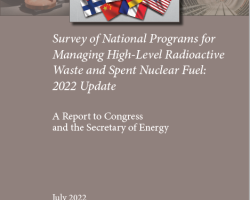Category of Content
Siting Experience Documents Only
Publication Date
Subject Matter
Hydride Rim Formation in Unirradiated Zircaloy
Hydride Rim Formation in Unirradiated Zircaloy
Effects of Multiple Drying Cycles on High-Burnup PWR Cladding Alloys
Effects of Multiple Drying Cycles on High-Burnup PWR Cladding Alloys
Effects of Lower Drying-Storage Temperature on the Ductility of High-Burnup PWR Cladding
Effects of Lower Drying-Storage Temperature on the Ductility of High-Burnup PWR Cladding
FY 2014 PNNL Zr Cladding Testing Status
FY 2014 PNNL Zr Cladding Testing Status
Report on UQ and PCMM Analysis of Vacuum Drying for UFD S&T Gaps
Report on UQ and PCMM Analysis of Vacuum Drying for UFD S&T Gaps
Verification and Validation Strategy for Implementation of Hybrid Potts-Phase Field Hydride Modeling Capability in MBM
Verification and Validation Strategy for Implementation of Hybrid Potts-Phase Field Hydride Modeling Capability in MBM
Documentation of Hybrid Hydride Model for Incorporation into Moose Bison and Validation Strategy
Documentation of Hybrid Hydride Model for Incorporation into Moose Bison and Validation Strategy
Model for Simulation of Hydride Precipitation in Zr-Based Used Fuel Claddings: A Status Report on Current Model Capabilities
Model for Simulation of Hydride Precipitation in Zr-Based Used Fuel Claddings: A Status Report on Current Model Capabilities
Assessment of Research Needs for Actinide and Brine Chemistry in Support of an HLW Repository in Salt
Assessment of Research Needs for Actinide and Brine Chemistry in Support of an HLW Repository in Salt
Assessment of Research Needs for Actinide and Brine Chemistry in Support of an HLW Repository in Salt
Assessment of Research Needs for Actinide and Brine Chemistry in Support of an HLW Repository in Salt
Experimental Investigation of Two-Phase Flow in Rock Salt
Experimental Investigation of Two-Phase Flow in Rock Salt
Optimization of Hydride Rim Formation in Unirradiated Zr-4 Cladding?
Optimization of Hydride Rim Formation in Unirradiated Zr-4 Cladding?
Modeling and Simulation of Used Nuclear Fuel During Transportation with Consideration of Hydride Effects and Cyclic Fatigue
Modeling and Simulation of Used Nuclear Fuel During Transportation with Consideration of Hydride Effects and Cyclic Fatigue
Modeling of hydride precipitation and reorientation
Modeling of hydride precipitation and reorientation
Roadmap for Developing a Computation Tool for Prediction of Hydride Precipitation and Reorientation during Long-Term Dry-Storage
Roadmap for Developing a Computation Tool for Prediction of Hydride Precipitation and Reorientation during Long-Term Dry-Storage
Modeling Hydride Reorientation in Cladding
Modeling Hydride Reorientation in Cladding
White Paper Summary of 2nd ASTM International Workshop on Hydrides in Zirconium Alloy Cladding
White Paper Summary of 2nd ASTM International Workshop on Hydrides in Zirconium Alloy Cladding
Guidance for Creating a Community Benefits Plan for Regional Direct Air Capture Hubs
Guidance for Creating a Community Benefits Plan for Regional Direct Air Capture Hubs
This document is intended to provide supplemental information to assist applicants developing a Community Benefits Plan (CBP) for the Regional Direct Air Capture Hubs. As shown in the graphic to the right, Community Benefits Plans are based on a set of four core interdependent policy priorities: engaging communities and labor; investing in America's workforce; advancing diversity, equity, inclusion, and accessibility; and implementing Justice40.
Policies for Achieving Energy Justice in Society: Best Practices for Applying Solar Energy Technologies to Low-Income Housing
Policies for Achieving Energy Justice in Society: Best Practices for Applying Solar Energy Technologies to Low-Income Housing
Studies indicate that the energy burden — energy costs as a percentage of annual family income — on low-income families is inordinately high, compared to that of the rest of the population. Rising fuel costs exacerbate this problem. Residential solar energy systems can help address this situation by furnishing a price-stable energy source with the added benefit of reduced greenhouse gas emissions. However, without appropriate incentives, these systems are prohibitively expensive for low-income families.
Survey of National Programs for Managing High-Level Radioactive Waste and Spent Nuclear Fuel: 2022 Update
Survey of National Programs for Managing High-Level Radioactive Waste and Spent Nuclear Fuel: 2022 Update
In October 2009, the U.S. Nuclear Waste Technical Review Board (Board or NWTRB) published Survey of National Programs for Managing High-Level Radioactive Waste and Spent Nuclear Fuel. For each of the 13 national programs studied, the report catalogued 15 institutional arrangements that had been set in place and 15 technical approaches that had been taken to design repository systems for the long-term management of high-activity radioactive waste.

